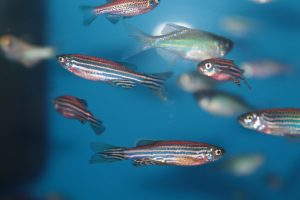Researchers from Harvard and Emory University report that they have developed the first fully-autonomous biohybrid fish from human stem-cell derived cardiac muscle cells. The artificial fish swims by recreating the muscle contractions of a pumping heart which, the team says, brings scientists one step closer to developing a more complex artificial muscular pump and providing a platform to study heart disease like arrhythmia.
“Our ultimate goal is to build an artificial heart to replace a malformed heart in a child,” noted Kit Parker, the Tarr Family Professor of Bioengineering and Applied Physics at the Harvard John A. Paulson School of Engineering and Applied Sciences (SEAS) and senior author of the paper. “Most of the work in building heart tissue or hearts, including some work we have done, is focused on replicating the anatomical features or replicating the simple beating of the heart in the engineered tissues. But here, we are drawing design inspiration from the biophysics of the heart, which is harder to do.
“Now, rather than using heart imaging as a blueprint, we are identifying the key biophysical principles that make the heart work, using them as design criteria, and replicating them in a system, a living, swimming fish, where it is much easier to see if we are successful.”
The study (“An autonomously swimming biohybrid fish designed with human cardiac biophysics”) is published in Science.
“Biohybrid systems have been developed to better understand the design principles and coordination mechanisms of biological systems. We consider whether two functional regulatory features of the heart—mechanoelectrical signaling and automaticity—could be transferred to a synthetic analog of another fluid transport system: a swimming fish. By leveraging cardiac mechanoelectrical signaling, we recreated reciprocal contraction and relaxation in a muscular bilayer construct where each contraction occurs automatically as a response to the stretching of an antagonistic muscle pair.
“Further, to entrain this closed-loop actuation cycle, we engineered an electrically autonomous pacing node, which enhanced spontaneous contraction. The biohybrid fish equipped with intrinsic control strategies demonstrated self-sustained body–caudal fin swimming, highlighting the role of feedback mechanisms in muscular pumps such as the heart and muscles.”

In this research, the team used human stem-cell derived cardiomyocytes to build the first autonomous biohybrid device, which was inspired by the shape and swimming motion of a zebrafish. Unlike previous devices, the biohybrid zebrafish has two layers of muscle cells, one on each side of the tail fin. When one side contracts, the other stretches. That stretch triggers the opening of a mechanosensitive protein channel, which causes a contraction, which triggers a stretch and so on, leading to a closed loop system that can propel the fish for more than 100 days.
“By leveraging cardiac mechano-electrical signaling between two layers of muscle, we recreated the cycle where each contraction results automatically as a response to the stretching on the opposite side,” said Keel Yong Lee, PhD, a postdoctoral fellow at SEAS and co-first author of the study. “The results highlight the role of feedback mechanisms in muscular pumps such as the heart.”
The researchers also engineered an autonomous pacing node, like a pacemaker, which controls the frequency and rhythm of these spontaneous contractions. Together, the two layers of muscle and the autonomous pacing node enabled the generation of continuous, spontaneous, and coordinated, back-and-forth fin movements.
“Because of the two internal pacing mechanisms, our fish can live longer, move faster and swim more efficiently than previous work,” said Sung-Jin Park, PhD, a former postdoctoral fellow in the Disease Biophysics Group at SEAS and co-first author of the study. “This new research provides a model to investigate mechano-electrical signaling as a therapeutic target of heart rhythm management and for understanding pathophysiology in sinoatrial node dysfunctions and cardiac arrhythmia.”
Park is currently an assistant professor at the Coulter Department of Biomedical Engineering at Georgia Institute of Technology and Emory University School of Medicine.
The team points out that unlike a fish for dinner in a refrigerator, this biohybrid fish improves with age. Its muscle contraction amplitude, maximum swimming speed, and muscle coordination all increased for the first month as the cardiomyocyte cells matured. Eventually, the biohybrid fish reached speeds and swimming efficacy similar to zebrafish in the wild.
Next, the team aims to build even more complex biohybrid devices from human heart cells.
“I could build a model heart out of Play-Doh, it doesn’t mean I can build a heart,” said Parker. “You can grow some random tumor cells in a dish until they curdle into a throbbing lump and call it a cardiac organoid. Neither of those efforts is going to, by design, recapitulate the physics of a system that beats over a billion times during your lifetime while simultaneously rebuilding its cells on the fly. That is the challenge. That is where we go to work.”



